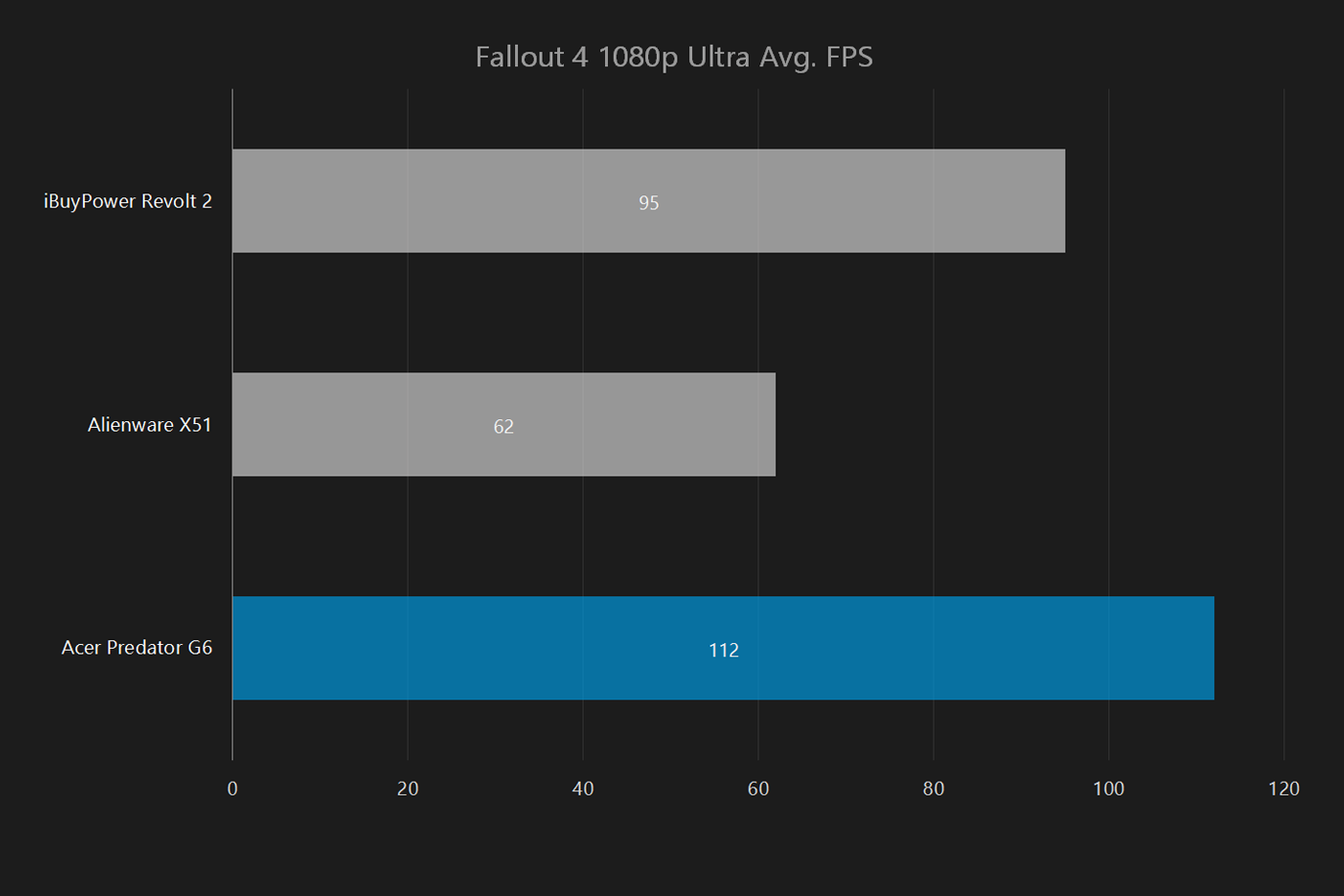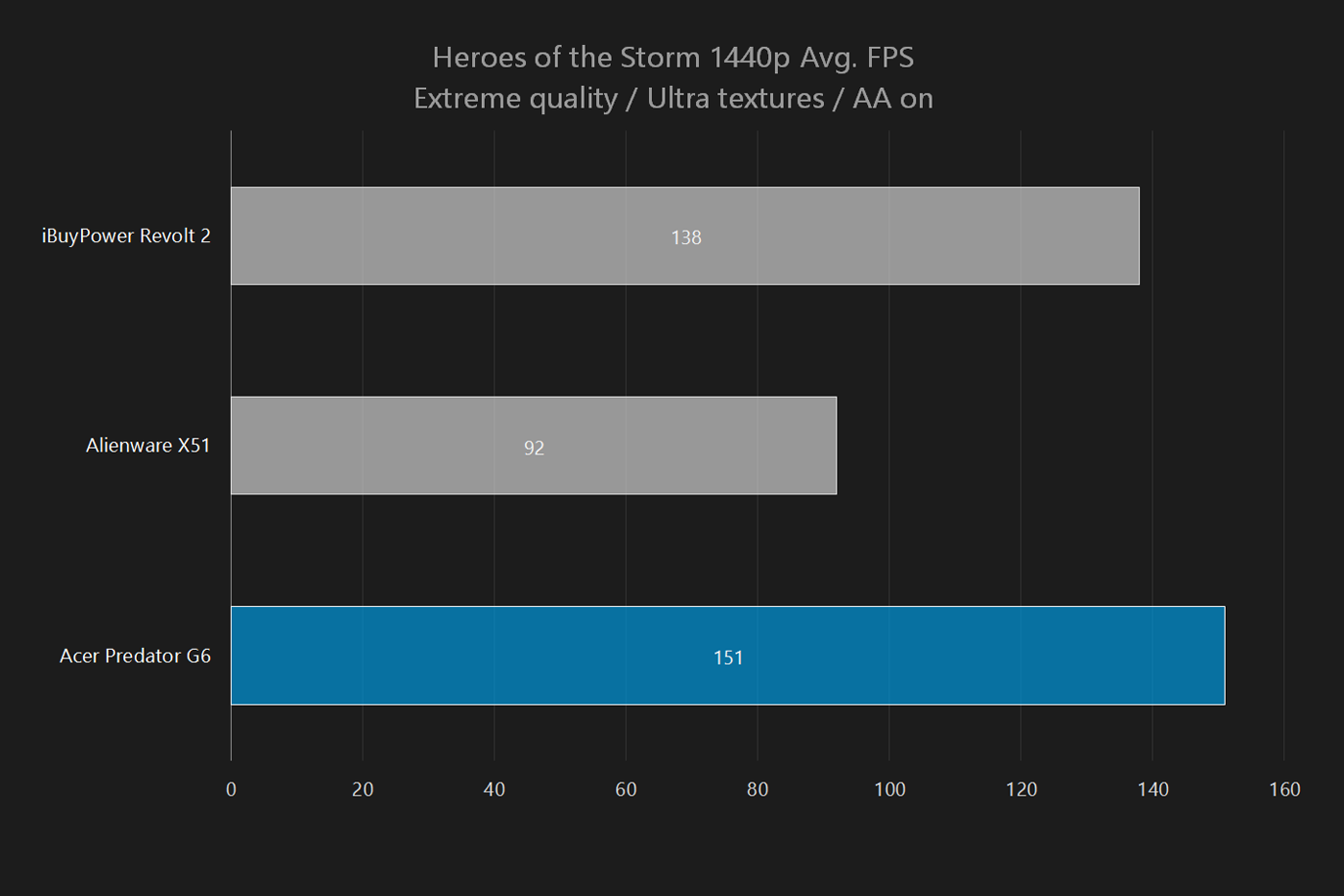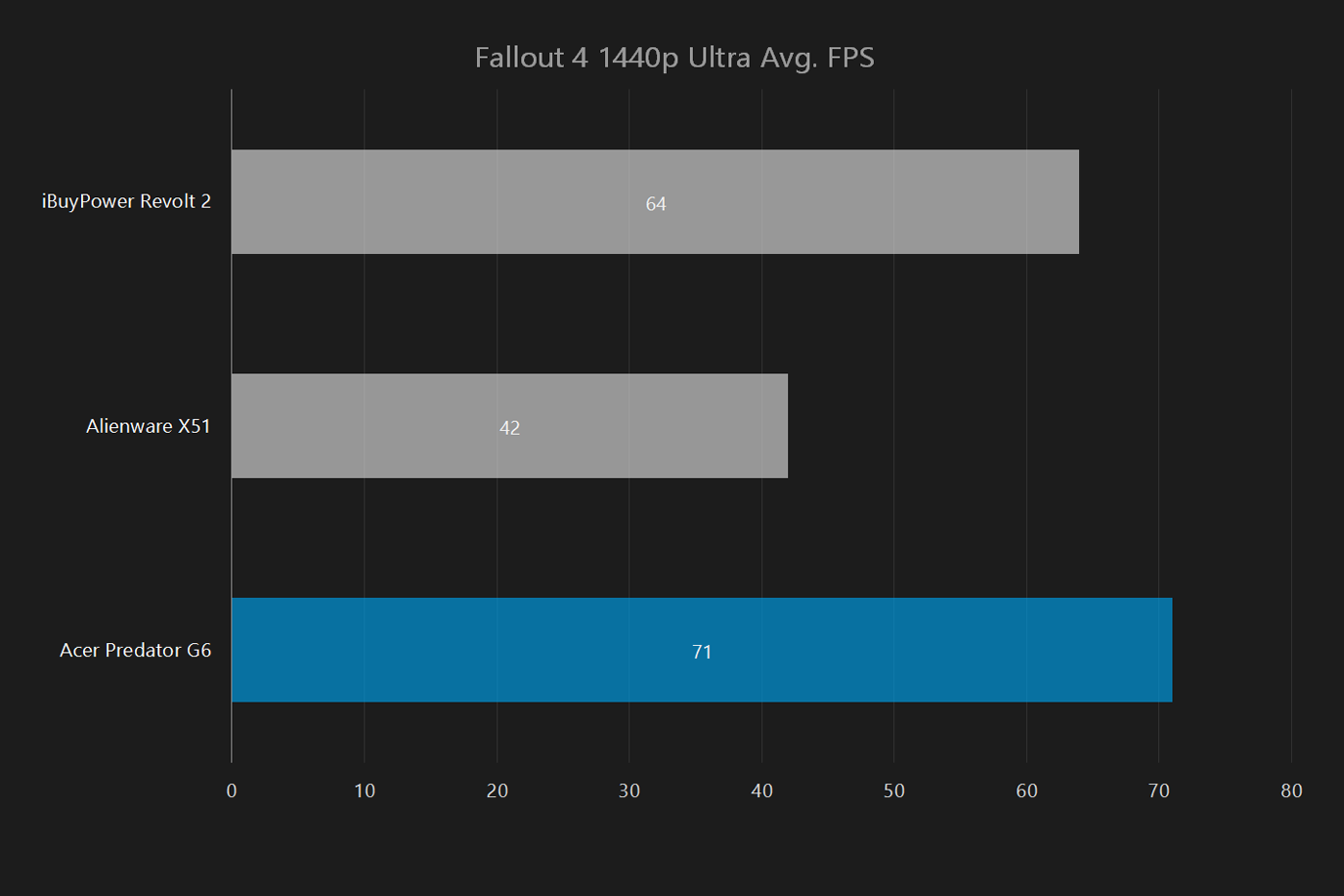
“Acer’s Predator G6 can hunt now, but limited upgrades may limit its glory years.”
- Gritty, yet subtle design
- Strong processor performance
- Can handle games at 1080p or 1440p
- Quiet, even at full load
- Minimal bloatware
- Cramped interior
- Some low-quality components
- Mediocre value
Big PC manufacturers have a long history of trying to enter the enthusiast gaming space, and an equally long history of failure. Only Dell has been successful, and that’s due to its purchase of Alienware, one of the most well-known names in all of PC gaming. Acer, Asus, HP and Lenovo have all made similar efforts, and while they’ve enjoyed success in the realm of mobile gaming, the desktop arena is a different story.
[specifications product_id=”922076″ align=”right”]
But Acer isn’t giving up. At IFA 2015 it announced a major effort to earn credibility in the eyes of gamers. To achieve that, it launched new notebooks, desktops, and monitors. We’re already smitten with the Acer Predator 17, which we think is the best gaming notebook on sale today. Acer hopes to follow up on that success with the Predator G6, its most expensive and extravagant desktop.
Perhaps extravagant isn’t the right word. Acer’s flagship system has strong, but typical, hardware. An Intel Core i7-6700K processor is paired with 16GB of DDR4 RAM, an Nvidia GTX 980 graphics card, and two hard drives, one a 256GB SATA solid state unit, the other a 2TB mechanical disk. While such hardware can certainly be expected to game, it’s a bit odd to see such tame specifications in a top-shelf gaming PC. Most competitors offer dual-graphics as an option, at least.
As you’d expect, the mid-range hardware results in a mid-range price of just $2,000. While that’s a lot more than most people pay for a PC, it’s not shocking for a gaming desktop. Can the Predator G6 buck the trend of lackluster big-brand rigs and become an everyday hero?
My PC is tank
The phrase “built like a tank” is thrown around a lot, but with the Predator G6, it’s literally true. Acer’s custom enclosure takes inspiration from a tank’s tread, which means a busy, scale-like pattern that wraps around the case like a belt.
Though it doesn’t look it at first, the Predator is rather subtle when placed in a room. Its dark exterior and minimal use of LED lighting (there’s just two dim red strips in the side panels) make for a system that can easily fade into the background if it’s not located prominently.
Plastic dominates the exterior, though a hint of metal appears now and then. While the “tread” looks segmented, the system is actually covered in large panels firmly connected to the enclosure’s metal interior frame by screws. The result is a sturdy, durable feel.
Several of the front panels swing away to reveal hidden functions, including a standard 5.25-inch optical drive, an external hard drive bay compatible with 2.5-inch drives, and a cradle which provides a place to hang your headset. The hidden panels feel robust, but like the rest of the exterior, they’re simple plastic – even the hinges. We’re not confident they’ll hold up after a few years of frequent use.
The usual ports
Two USB 3.0 ports, and the typical 3.5mm jacks for audio-out and audio-in, make up the front-facing connections. This is standard for the segment – nothing more than expected, and nothing less.
It’s the same around back. Six USB 3.0 ports, and two 2.0, are flanked by HDMI, DVI, and DisplayPort. There’s also a row of 3.5mm audio jacks, of course, and one Ethernet connection. Wireless connectivity includes 802.11ac Wi-Fi and Bluetooth 4.0 + LE.
Anatomy of a Predator
Accessing the Acer’s internals is not self-explanatory, as the armor-like exterior thwarts the obvious methods of taking apart the case. The trick can be found along the lower quarter of the back panel, where two recessed buttons unlatch the hooks holding it to the frame. From there it’s a simple matter of removing two screws bolting the side panel, and sliding said panel away.
Inside we found signs of cost-cutting, including messy cable routing.
That reveals a surprisingly small interior. At 21-inches tall, the Predator G6 is as large as many full ATX towers, but it only has room for a micro-ATX motherboard. There are two 3.5-inch hard drive bays, one of which is already filled, two free memory DIMMs, and little more for expansion. A second video card won’t fit.
Do-it-yourself types must also deal with a messy bundle of cables and wires. There’s no careful internal routing here, nor any recessed spaces for cable management, or even a modular power supply. Instead, most cables hang in a zip-tie tangle just behind the optical drive.
That’s exactly why big-brand manufacturers have a bad reputation in the world of hardcore PC gaming. Omitting a minor detail like careful cable routing may seem like a great way to cut costs, but it’s a red flag to enthusiasts who want a carefully built rig.
Processor performance
A Core i7-6700K is the heart of the Predator G6, and it’s paired with 16GB of DDR4 2133MHz memory. This combination is incredibly common. What’s less common is the Turbo button on the i7-6700K. Acer makes no claims on its website about what Turbo achieves, but in our rig it boosted the clock speed to almost 4.6GHz (4,579MHz, to be specific) up from a base clock of 4GHz. The gain clearly made a difference in our benchmarks.
The Predator G6 does well in our tests without Turbo, generally tying or beating the competition, but turning Turbo on gives it the edge. The Handbrake result is especially notable, as it’s way quicker than similarly priced systems we’ve recently tested. If you want to encode video, the G6 is your desktop.
Note, though, that the Acer’s price of $2,000 is about $450 more than either of the alternatives it’s compared to in the graphs above, so victory is to be expected. The Predator will have to prove itself elsewhere to earn its stripes.
Hard drive performance
Our review unit came with two drives, one a 256GB SATA solid state unit, the other a 2TB mechanical disk. We tested the former which, in our review unit, was Lite-On’s CV1 solid state drive.
The battle lines are clear, aren’t they? Acer’s Predator G6, and the iBuyPower Revolt 2, both shipped to us with SSDs that connect over the SATA interface – and they score similarly. The Alienware X51 was tested with a drive that connect over the much quicker PCI Express interface, and that makes all the difference. It destroys the competition.
Still, the Predator’s result isn’t bad. The performance you see above is near the top of what you can expect from a SATA hard drive. In actual use the drive feels quick, but it won’t transfer large files as quickly as a PCIe drive, such as the one found in the Alienware X51.
Graphics performance
While processor and hard drive performance have meaning, they’re sideshows to the main event. The Acer Predator G6 will live or die on its gaming performance. Its weapon of choice? Nvidia’s GTX 980.
We don’t see the 980 in many systems. Those sent to us usually opt for faster GTX 980 Ti, since it takes up the same amount of space, and isn’t much more difficult to cool. Strangely, the 980 Ti isn’t even an option for the Predator G6. You also can’t buy an AMD card – sorry, Radeon fans!
Let’s start with 3D Mark, a synthetic test that provides a good general overview of how a system’s gaming performance stacks up.

The Predator G6 wins, scoring about 1,500 higher than the iBuyPower Revolt 2 in Fire Strike. The poor Alienware X51, with its GTX 960, is left way behind either of its similarly priced peers. While this is an obvious win, the margin is too close for the Predator to get comfortable. Can it increase its lead in actual games?
Our 1080p test suite tells an (almost) consistent story. In most games the Predator G6 beats the iBuyPower Revolt 2 by around 15 percent, and leaves the Alienware X51 in the dust. Battlefield 4 is the exception, to the Predator’s favor. In that game the G6 destroys the competition.
Crysis 3 is the only game that dips below 60 frames per second (FPS) on the G6, and even then, only at the title’s absolutely maximum settings. The verdict is clear – if you game at 1080p, this rig can easily handle your needs.
But what about 1440p? Given its price and power, it’s realistic to think gamers eyeing this desktop have a quad-HD display at home.
This resolution is also within the Predator’s reach, as the desktop once again averages more than 60 FPS in every game, at maximum detail, except Crysis 3.
There is a problem, however. The less expensive iBuyPower Revolt 2, which we reviewed with an Nvidia GTX 970, also hits that mark. It’s once again slower by about 15 percent, but whether that performance gap is noticeable in real-world scenarios is questionable.
And that’s the trap Acer’s Predator falls into. While it performs well in all our gaming tests, its improvement over recent competitors falls in line with its higher price. There is a less expensive G6 model available, with a GTX 970, for $1,500. But that version downgrades the solid state drive to 128GB, and cuts RAM in half, once again putting the G6 in an awkward position.
Stalking in silence
Our review unit arrived with a quirky fan that made a bit of a grinding noise. We don’t believe it reflects the system’s general quality, but we thought it should be mentioned. While the grind was noticeable because of its pitch, it didn’t register as loud on our decibel meter. According to it, the Predator G6 produced just 38.6 decibels of ruckus at idle.
Running the 7-Zip processor benchmark didn’t increase the system’s volume at all, even with Turbo on. Furmark, a graphical stress test, increased fan noise to 41.5dB, which is low for the category. The Alienware X51 is a few tenths of a decibel quieter, but the iBuyPower Revolt 2 is several decibels louder, and three-quarters of all gaming desktops we’ve tested over the last year exceed 45dB in Furmark.
A lean hunter
Acer thankfully ships the Predator G6 with almost zero bloatware. Only a few Acer programs appear, all of them minimally intrusive. One of the programs, Acer PredatorSense, is used to turn the red Turbo lighting on or off, alter Turbo mode in software, and view a few details like current CPU temperature and fan speed. It’s useful, attractive, and loads quickly.
Warranty
A two-year warranty against manufacturing defects is included with the Predator G6. That’s slightly better than most competitors. Additionally, Acer provides an special customer support line that is reserved for Predator customers. Additional warranty extensions up to a total of four years can be purchased. On the downside, Acer does not provide the free lifetime labor service that is offered by a lot of smaller PC builders.
Conclusion
Acer’s Predator G6 doesn’t dominate its field, as does Acer’s Predator 17 gaming laptop, but it’s a solid entry. At $2,000 it ranks mid-pack in value, coming in higher than the iBuyPower Revolt 2 and Asus’ similar G11CD desktop, which is $1,700. But the Predator is a lot more affordable than a full-custom rig from Alienware, Falcon Northwest, or Origin, and is about tied with Digital Storm’s Vanquish 4.
The enclosure is what defines the Predator G6. It’s the rig’s greatest strength, and biggest weakness. Acer’s design looks like it means business and incorporates some useful features, like a swappable hard drive bay and Turbo button. Asus’ previously mentioned G11CD looks like a Honda Civic with a wing on it. The G6 looks like a Mustang GT 500.
But like a Mustang, the interior is tighter than the exterior suggests, and show signs of cost-cutting. Yes, the Predator can hunt now. What about five years down the road, when it needs a new processor and video card? That’s different. The internals aren’t a great foundation for future upgrades.
It’s a shame. The Acer Predator G6 has the exterior of a serious gaming rig, and nails the performance, too. Yet it doesn’t seal the deal by offering quality interior components and plenty of room for upgrades. Gamers who want strong performance at a reasonable price should consider the G6, but beware. You’ll likely need to buy an all-new rig when it comes time to upgrade.
Editors' Recommendations
- Acer Predator doubles down on OLED, mini-LED, and extreme curves
- Acer has a massive 45-inch OLED Predator gaming monitor for CES 2023
- Acer Predator Triton 300 SE 16 hands-on review: Larger and in charge
- Acer’s TV-sized Predator gaming monitor is OLED, 4K, and living room-ready
- New Predator Triton 500 SE, Helios 300, and Nitro 5 laptops land at CES 2022























